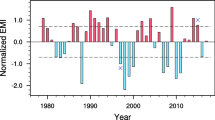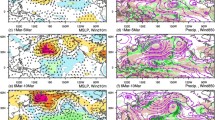Abstract
Previous study reported that the annual-mean eastern Oyashio Extension (OE) front shifts northward while the western OE front has no obvious poleward shift during 1982–2017 by Wu et al. (Geophys Res Lett 45:9042–9048, 2018). Here we revisit this topic and focus on the seasonal variability and shifts of the OE fronts from 1982 to 2018, with observational reanalysis data and a 1.5-layer reduced-gravity model simulation. In winter, both the western and eastern OE fronts demonstrate consistent northward movement. While in summer, the eastern OE front still moves northward but the western OE front has no obvious and even southward shift. It is shown that the trade wind’s expansion during 1982–2018 favours the northward shift of the OE fronts for both winter and summer. However, there is a local cold Ekman heat transport anomaly along the western OE front in summer, which surpasses the effect of trade wind expansion and prohibits northward movement of the front. This cold Ekman advection is due to a westerly wind anomaly induced firstly by the Atlantic Multi-decadal Oscillation (AMO) and secondly by the Pacific Decadal Oscillation (PDO). In winter, the local Ekman heat transport is less effective than in summer in changing the OE front position because of the deep mixed layer. Our study demonstrates the seasonality of the OE front shift and highlights the importance of local Ekman heat transport associated with the AMO. Our results also partly explain the rainfall changes in both winter and summer in the western Pacific Ocean in the past 37 years, since the rainband east of Japan is affected by the sea surface temperature and its front.















Similar content being viewed by others
References
Bretherton CS, Widmann M, Dymnidov VP, Wallace JM, Blade I (1999) The effective number of spatial degrees of freedom of a time-varying field. J Clim 12:1990–2009. https://doi.org/10.1175/1520-0442(1999)012%3c1990:TENOSD%3e2.0.CO;2
Chen X, Zhang X, Church JA, Watson CS, King MA, Monselesan D, Legresy B, Harig C (2017) The increasing rate of global mean sea-level rise during 1993–2014. Nat Clim Change 7:492–497. https://doi.org/10.1038/NCLIMATE3325
Dee DP, Uppala SM, Simmons AJ, Berrisford P, Poli P, Kobayashi S et al (2011) The ERA-Interim reanalysis: configuration and performance of the data assimilation system. Q J R Meteorol Soc 137:553–597. https://doi.org/10.1002/qj.828
Deser C, Blackmon ML (1995) On the relationship between tropical and North Pacific sea surface temperature variations. J Clim 8:1677–1680. https://doi.org/10.1175/1520-0442(1995)008%3c1677:OTRBTA%3e2.0.CO;2
Enfield DB, Mestas-Nunez AM, Trimble PJ (2001) The Atlantic multidecadal oscillation and its relation to rainfall and river flows in the continental US. Geophys Res Lett 28:2077–2080
Hautala SL, Roemmich DH, Schmitz WJ Jr (1994) Is the North Pacific in Sverdrup balance along 24°N? J Geophys Res 99:16041–16052. https://doi.org/10.1029/94JC01084
Hurrell JW et al (2013) The community earth system model: a framework for collaborative research. Bull Am Meteorol Soc 94:1339–1360. https://doi.org/10.1175/BAMS-D-12-00121.1
Isoguchi O, Kawamura H, Oka E (2006) Quasi-stationary jets transporting surface warm waters across the transition zone between the subtropical and the subarctic gyres in the North Pacific. J Geophys Res 111:c10003. https://doi.org/10.1029/2005JC003402
Jing Z, Chang P, Shan X, Wang S, Wu L, Kurian J (2019) Mesoscale SST dynamics in the Kuroshio–Oyashio extension region. J Phys Oceanogr 49:1339–1352. https://doi.org/10.1175/jpo-d-18-0159.1
Kalnay E, Kanamitsu M, Kistler R, Collins W, Deaven D, Gandin L, Iredell M, Saha S, White G, Woollen J, Zhu Y, Chelliah M, Ebisuzaki W, Higgins W, Janowiak J, Mo KC, Ropelewski C, Wang J, Leetmaa A, Reynolds R, Jenne R, Joseph D (1996) The NCEP–NCAR 40-year reanalysis project. Bull Am Meteorol Soc 77:1057–1072. https://doi.org/10.1175/1520-0477(1996)077%3C0437:TNYRP%3E2.0.CO;2
Kanamitsu M, Ebisuzaki W, Woollen J, Yang SK, Hnilo JJ, Fiorino M, Potter GL (2002) NCEP-DOE AMIP-II reanalysis (R-2). Bull Am Meteorol Soc 83:1631–1643. https://doi.org/10.1175/BAMS-83-11-1631
Kuroda H, Wagawa T, Shimizu Y, Ito S, Kakehi S, Okunishi T, Ohno S, Kusaka A (2015) Interdecadal decrease of the Oyashio transport on thecontinental slope off the southeastern coast of Hokkaido, Japan. J Geophys Res 120:2504–2522. https://doi.org/10.1002/2014JC010402
Larson SM, Vimont DJ, Clement AC, Kirtman BP (2018) How momentum coupling affects sst variance and large-scale pacific climate variability in CESM. J Clim 31:2927–2944. https://doi.org/10.1175/JCLI-D-17-0645.1
Li JP, Sun C, Jin F-F (2013) NAO implicated as a predictor of Northern Hemisphere mean temperature multidecadal variability. Geophys Res Lett 40:5497–5502. https://doi.org/10.1002/2013gl057877
Locarnini RA et al (2013) World ocean Atlas 2013, volume 1: temperature. In: Levitus S (Ed) A. Mishonov technical Ed.; NOAA Atlas NESDIS 73, 40 pp
Lucas C, Timbal B, Nguyen H (2014) The expanding tropics: a critical assessment of the observational and modeling studies. Wires Clim Change 5:89–112. https://doi.org/10.1002/wcc.251
Mantua NJ, Hare SR, Zhang Y, Wallace JM, Francis RC (1997) A Pacific interdecadal climate oscillation with impacts on salmon production. Bull Am Meteorol Soc 78:1069–1079. https://doi.org/10.1175/1520-0477(1997)078%3C1069:APICOW%3E2.0.CO;2
Miller AJ, Cayan DR, Barnett TP, Graham NE, Oberhuber JM (1994) Interdecadal variability of the Pacific Ocean: model response to observed heat flux and wind stress anomalies. Clim Dyn 9:287–302. https://doi.org/10.1007/BF00204744
Minobe S, Miyashita M, Kuwano-Yoshida A, Tokinaga H, Xie SP (2010) Atmospheric response to the gulf stream: seasonal variations. J. Climate 23:3699–3719. https://doi.org/10.1175/2010jcli3359.1
Monterey GI, Levitus S (1997) Seasonal variability of mixed layer depth for the world ocean. NOAA Atlas NESDIS 14, 96 pp
Nakamura H, Lin G, Yamagata T (1997) Decadal climate variability in the North Pacific during the recent decades. Bull Am Meteorol Soc 78:2215–2225. https://doi.org/10.1175/1520-0477(1997)078%3c2215:DCVITN%3e2.0.CO;2
Oka E, Qiu B, Kouketsu S, Uehara K, Suga T (2012) Decadal seesaw of the central and subtropical mode water formation associated with the Kuroshio extension variability. J Oceanogr 68:355–360. https://doi.org/10.1007/s10872-015-0300-x
Qiu B (2003) Kuroshio Extension variability and forcing of the Pacific decadal oscillations: responses and potential feedback. J Phys Oceanogr 33:2465–2482. https://doi.org/10.1175/2459.1
Qiu B, Kelly KA (1993) Upper ocean heat balance in the Kuroshio Extension region. J Phys Oceanogr 23:2027–2041. https://doi.org/10.1175/1520-0485(1993)023%3c2027:UOHBIT%3e2.0.CO;2
Qiu B, Lukas R (1996) Seasonal and interannual variability of the North equatorial current, the Mindanao current and the Kuroshio along the Pacific western boundary. J Geophys Res 101:12315–12330. https://doi.org/10.1029/95JC03204
Qiu B, Chen S, Schneider N (2017) Dynamical links between the decadal variability of the Oyashio and Kuroshio extensions. J Clim 30:9591–9605. https://doi.org/10.1175/JCLID-17-0397.1
Reynolds RW, Smith TM, Liu C, Chelton DB, Casey KS, Schlax MG (2007) Daily high-resolution-blended analyses for sea surface temperature. J. Climate 20:5473–5496. https://doi.org/10.1175/2007JCLI1824.1
SSALTO/DUACS (2013) SSALTO/DUACS User Handbook: (M)SLA and (M)ADT Near-real time and delayed time products
Sun C, Kucharski F, Li J, Jin FF, Kang IS, Ding RQ (2017) Western tropical Pacific multidecadal variability forced by the Atlantic multidecadal oscillation. Nat. Commun 8:15998. https://doi.org/10.1038/ncomms15998
Sverdrup HU (1947) Wind-driven currents in a baroclinic ocean with application to the equatiorial currents of the eastern Pacific. Proc Natl Acad Sci USA 33:318–326
Taguchi B, Xie SP, Schneider N, Nonaka M, Sasaki H, Sasai Y (2007) Decadal variability of the Kuroshio extension. Observations and an eddy-resolving model hindcast. J Clim 20:2357–2377. https://doi.org/10.1175/JCLI4142.1
Trenberth KE, Hurrell JW (1994) Decadal atmosphere-ocean variations in the Pacifc. Clim Dyn 9:303–319. https://doi.org/10.1007/BF00204745
Wang J, Kim HM, Chang EKM (2017) Changes in Northern hemisphere winter storm tracks under the background of arctic amplification. J Clim 30:3705–3724. https://doi.org/10.1175/JCLI-D-16-0650.1
Wu L, Li C, Yang C, Xie SP (2008) Global teleconnections in response to a shutdown of the Atlantic meridional overturning circulation. J Clim 21:3002–3019. https://doi.org/10.1175/2007JCLI1858.1
Wu B, Lin X, Qiu B (2018) Meridional shift of the Oyashio extension front in the past 36 years. Geophys Res Lett 45:9042–9048. https://doi.org/10.1029/2018GL078433
Xie SP, Philander SGH (1994) A coupled ocean-atmosphere model of relevance to the ITCZ in the eastern Pacific. Tellus 46:340–350. https://doi.org/10.1034/j.1600-0870.1994.t01-1-00001.x
Yuan XJ, Talley LD (1996) The subarctic frontal zone in the North Pacific: characteristics of frontal structure from climatological data and synoptic surveys. J Geophys Res 101:16491–16508. https://doi.org/10.1029/96JC01249
Zhang R, Delworth TL (2007) Impact of the atlantic multidecadal oscillation on North Pacific climate variability. Geophys Res Lett 34:229–241. https://doi.org/10.1029/2007GL031601
Zweng MM et al (2013) World ocean Atlas 2013, volume 2: salinity. Levitus S (Ed) A. Mishonov technical Ed.; NOAA Atlas NESDIS 74, 39 pp
Acknowledgements
Xiaopei Lin is supported by the China’s national key research and development projects (2016YFA0601803), the Qingdao National Laboratory for Marine Science and Technology (2017ASKJ01) and the National Natural Science Foundation of China (41490641, 41521091 and U1606402). The software used to generate all the results in this study is MATLAB.
Author information
Authors and Affiliations
Corresponding author
Additional information
Publisher's Note
Springer Nature remains neutral with regard to jurisdictional claims in published maps and institutional affiliations.
Electronic supplementary material
Below is the link to the electronic supplementary material.
Rights and permissions
About this article
Cite this article
Wu, B., Lin, X. & Qiu, B. On the seasonal variability of the Oyashio extension fronts. Clim Dyn 53, 7011–7025 (2019). https://doi.org/10.1007/s00382-019-04972-1
Received:
Accepted:
Published:
Issue Date:
DOI: https://doi.org/10.1007/s00382-019-04972-1




